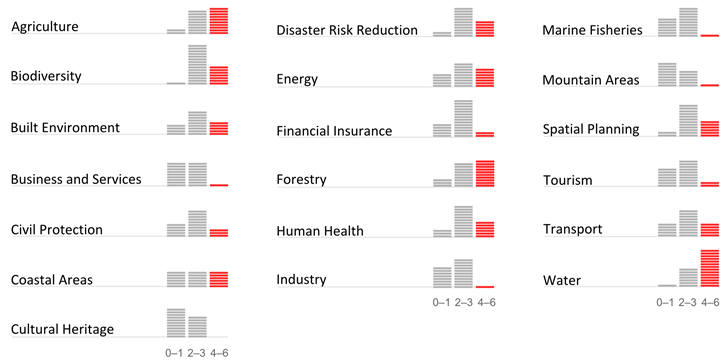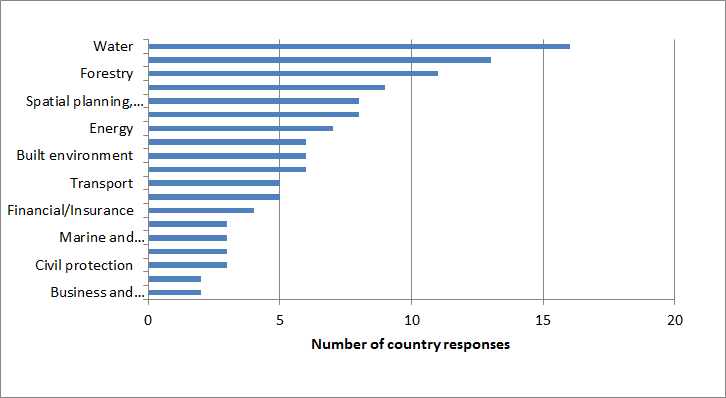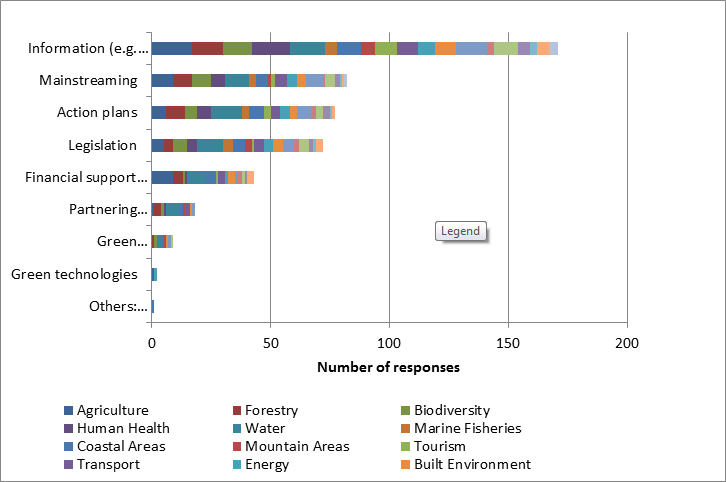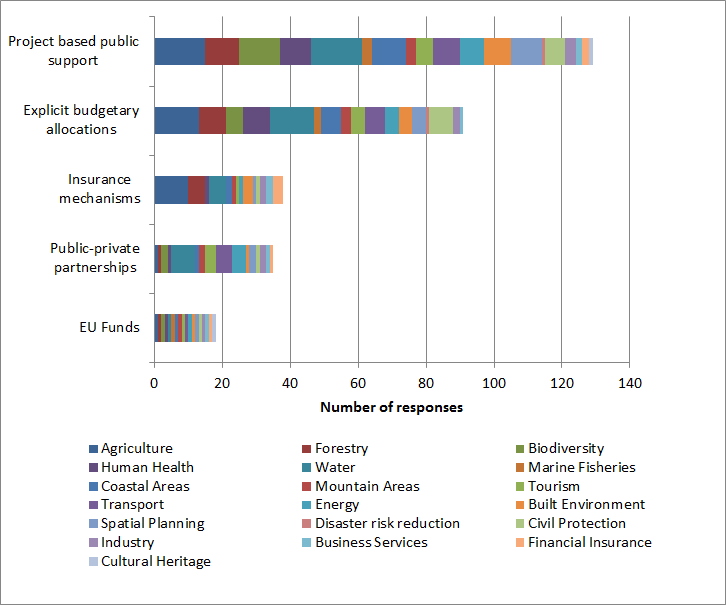Table of contents
- Acknowledgements
- Executive summary
- Objectives, intended users and context of this report
- Outline of this report
- Methodological approach
- Lessons learned from collaborating with member countries through the self-assessment survey
- 1. Rationale for public intervention on adaptation
- 2.1. Key Topic 1: Public and policy awareness of the need for adaptation
- 2.1.1. Awareness of the need for adaptation: what does this include?
- 2.1.2. Findings from self-assessment survey
- 2.1.3. Examples from countries
- 2.1.4. Discussion of findings
- 2.2. Key Topic 2: Knowledge generation and use
- 2.2.1. Knowledge generation and use: what does this include?
- 2.2.2. Findings from self-assessment survey
- 2.2.3. Examples from countries
- 2.2.4. Discussion of findings
- 2.3. Key Topic 3: Planning adaptation
- 2.3.1. Planning adaptation: what does this include?
- 2.3.2. Findings from self-assessment survey
- 2.3.3. Examples from countries
- 2.3.4. Discussion of findings
- 2.4. Key Topic 4: Coordination of adaptation
- 2.4.1. Coordination of adaptation: what does this include?
- 2.4.2. Findings from self-assessment survey
- 2.4.3. Examples from countries
- 2.4.4. Discussion of findings
- 2.5. Key Topic 5: Stakeholder involvement
- 2.5.1. Stakeholder involvement: what does this include?
- 2.5.2. Findings from self-assessment survey
- 2.5.3. Examples from countries
- 2.5.4. Discussion of findings
- 2.6. Key Topic 6: Implementation of adaptation
- 2.6.1. Implementation of adaptation: what does this include?
- 2.6.2. Findings from self-assessment survey
- 2.6.3. Examples from countries
- 2.6.4. Discussion of findings
- 2.7. Key Topic 7: Transnational cooperation
- 2.7.1. Transnational cooperation: what does this include?
- 2.7.2. Findings from self-assessment survey
- 2.7.3. Examples from countries
- 2.7.4. Discussion of findings
- 2.8. Key Topic 8: Monitoring, reporting and evaluation
- 2.8.1. Monitoring, reporting and evaluation (MRE): what does this include?
- 2.8.2. Findings from the self-assessment survey
- 2.8.3. Examples from countries
- 2.8.4. Discussion of findings
- 3. The evolving agenda for national adaptation in Europe
- 4. Glossary
- 5. Acronyms
- 6. References
2.6.2. Findings from self-assessment survey
This key topic is based on findings from eight questions with focus on implementing adaptation. All questions in the self-assessment survey - except two (Q34 and Q42) - were closed and most included multiple choice options. The table below presents the list of questions and indicates the number of countries having answered them. In total, 30 countries returned the self-assessment survey to the EEA.
| Question from self-assessment survey (including the question number) | Number of countries having answered this question (including % on total number) |
|---|---|
| In my country, integration of adaptation into sectoral policies and programmes is increasing. (Q8) | 30/30 (100 %) |
| In what stage of the adaptation policy process is your country in? (Q12) | 30/30 (100 %) |
| Please highlight the relevant sectors/areas in your country and assess the current state of adaptation at various levels. (Q31) | 26/30 (86 %) |
| Are you using policy instruments (see question 33 below for examples) for implementing adaptation actions? (Q32) | 26/30 (87 %) |
| If you are already using instruments for implementing adaptation, what are the main instruments in the different sectors in your country? (Q33) | 19/30 (63 %) |
| If (additional) instruments for implementation are planned in your country, what are the main instruments you are considering? (Q34) | 12/30 (40 %) |
| What are the most important financing mechanisms currently in place (or the mechanisms that will be considered in the future) for implementing adaptation in the sectors you have identified as relevant in your country? (Q35) | 20/30 (67 %) |
| What are the next steps your country is planning? Please provide information on the following issues and the related timing (addressing both national and sub-national levels): focus on implementation (Q42) | 22/30 (73 %) |
Implementing adaptation is still at an early stage across Europe
Overall, the response from 30 European countries shows that implementing adaptation is still at an early stage across Europe. Nevertheless, the self-assessment survey demonstrates a varying picture when taking into account for example the different stages of policy making or sectoral activities in the countries. Implementation is most advanced in the water sector, followed by agriculture and forestry. In industry and business, very little or no adaptation activity has been reported by the member countries. In addition, most activities have been reported for the national level.
Ten out of 30 countries report that they are in the implementation stage of the adaptation policy process
Ten countries described themselves as being in the implementation stage of their national adaptation policy process: Austria, Denmark, Finland, France, Lithuania, Malta, Norway, Spain, Switzerland and the UK. All of these countries have adopted a national adaptation strategy (NAS) and national action plans (NAP) (EEA, 2013, results from Self-assessment).
Some of these countries such as Finland, France, Lithuania and Spain indicated that for some sectors (e.g. water, human health) they have already implemented a portfolio of adaptation measures. The UK stated that for all priority sectors a portfolio of adaptation measures is in place and also being monitored/evaluated.
Most adaptation responses have been reported to be implemented at national level and in the water sector
The self-assessment survey shows that the national level is reported to be the most advanced in implementing adaptation measures (i.e. nationally funded or targeting the whole country). Furthermore, for most sectors, the sub-national level is suggested to be more active in implementing adaptation than the local level (e.g. cities). However, for the built environment, spatial/urban planning and disaster risk reduction more activity on adaptation implementation is reported at the local/city level than at other sub-national levels.
The frontrunner in implementing adaptation at national level is the water sector (Figure 2.16). Results from the self-assessment survey show that 16 out of 26 countries are advanced in implementing adaptation measures in the water sector with either single adaptation measures (i.e. Cyprus, Denmark, Italy, Liechtenstein, Lithuania, Malta, The Netherlands, Poland, Slovenia, Switzerland, Turkey) or a portfolio of adaptation measures (i.e. Finland, France, Portugal, Spain, UK).
The scoring of the stage of adaptation in various sectors also corresponds well with the selection of priority sectors as indicated by 17 member countries (Figure 2.17): the water sector as frontrunner in implementing adaptation also received most scores for being a priority sector/area for implementation, followed by agriculture, forestry and human health. Those sectors are also relatively advanced in putting adaptation into practice, as approximately one third of the countries answering this question have started with implementing adaptation measures in these sectors. In the case of human health, France and the UK have indicated that a portfolio of adaptation measures is in place and monitored.
Sectors where private actors play a large role (e.g. business and services, industries, finance/insurance as well as tourism) are reported to be not very active in implementation. They are also reported as less prioritised for adaptation across Europe (Figure 2.17) (not taking into account sectors which are defined by a specific geographical situation such as mountain or coastal areas).
Furthermore, no adaptation responses have been reported for the sector “cultural heritage”, which is indeed lower down on the list of priorities in adaptation implementation (Figure 2.17). Nevertheless, in Finland, climate change adaptation is integrated in the revised Strategy of the Cultural Environment (2014).
Figure 2.16 Adaptation progress at national level; Source: EEA Self-assessment survey (n= 26)

Legend:
0 = adaptation is not relevant for my country 1 = need for adaptation not recognised and no mesasures implemented yet
2 = coordination activities for adaptation started 3 = some adaptation measures identified for the sector but not yet implemented
4 = portfolio of adaptation measures identified and implementation (of some) launched
5 = portfolio of adaptation measures implemented
6 = portfolio of adaptation measures in place and monitored/evaluated
Figure 2.17 Priority sectors for adaptation implementation; Source: EEA Self-assessment survey (n= 17)

Countries can have very advanced adaptation measures in place in selected priority sectors, while still being at an early stage of adaptation policy making in general
In general, the self-assessment survey shows a lower level of adaptation put into practice for countries that are in earlier stages of policy-making than for countries that are in the implementation or monitoring and evaluation (M&E) stages. Nevertheless, some of these countries in earlier stages of policy-making have reported that selected sectors are already active with concrete adaptation initiatives, e.g. biodiversity1, human health, water (at sub-national level) and transport in Belgium; water, built environment and coastal areas in The Netherlands.
Adaptation implementation can also be observed in a few countries without an adaptation policy in place. For example, for most priority sectors (i.e. water, forestry) Italy reports that measures have been identified and some are already implemented. Liechtenstein indicates progress in putting some adaptation activities into practice in sectors such as water and energy.
Providing information is the most frequently reported policy instrument used for implementation
For all sectors/areas represented in the self-assessment survey, all 19 countries answering this question reported the provision of information as the most often used policy instrument for implementing adaptation (see Figure 2.18). The second most often used policy instrument reported is mainstreaming, highlighted for most sectors except for civil protection and cultural heritage (see following section on mainstreaming). Furthermore, action plans are often mentioned in the survey as policy instruments supporting implementation for all sectors/areas except for mountain areas. Less often reported as policy instruments are legislation and financial support (e.g. subsidies, taxes).
Countries at present seem to use partnering instruments, green technologies and legislative instruments only rarely for fostering implementation.
Looking at the use of policy instruments from a sectoral perspective, most instruments for implementation were reported for the water sector, a priority sector and frontrunner in adaptation. By contrast, in areas such as civil protection, finance and insurance, businesses and services as well as cultural heritage, so far only a few policy instruments have been used for implementing adaptation.
Countries in the implementation stage of the adaptation process (i.e. Denmark, Finland, France, Lithuania, Spain, Switzerland) or which have reported to put adaptation into practice mainly in selected sectors (i.e. Belgium, The Netherlands) reported a higher number of implementation instruments.
Figure 2.18 Policy instruments used for implementing adaptation; Source: EEA Self-assessment survey (n= 17)

The majority of countries use mainstreaming to foster adaptation
Mainstreaming is the second most often reported policy instrument for implementation for various sectors. In addition, 26 of 30 countries report integration of adaptation into sectoral policies and programmes to be increasing. In Table 2.11, examples of integrating adaptation into sectoral policies and programmes are presented.
Examples have a focus on environmental sectors such as water and forestry. Besides environment-related policies, mainstreaming adaptation into other policies has been mentioned, especially health by southern European countries. In addition, a few countries report efforts in integrating adaptation into infrastructure and building codes (Belgium, France, Denmark) or electricity (Finland). Guidelines for mainstreaming adaptation into Strategic Environmental Assessment (SEA) processes are noted by Ireland and Slovenia.
Table 2.11 Examples of mainstreaming adaptation into sectorial policies and programmes (Source: EEA self-assessment survey Q8)
| Country | EXAMPLES of mainstreaming adaptation into sectoral policies and programmes |
|---|---|
| Austria | various sectoral policies such as Forestry, Agriculture, Water management and Natural hazard management |
| Belgium | multi-departmental taskforces for adaptation established to ensure integration, various sectoral policies such as Water, Coastal areas, Biodiversity, Forestry, |
| Bulgaria | Forest policies |
| Cyprus | various sectoral policies such as the Water Framework Directive, Agriculture Policy |
| Czech Republic | n/a |
| Denmark | various sectoral policies such as Water, Building and Construction, Infrastructure and Spatial planning, Rescue preparedness |
| Estonia | integration as response to key EU policies such as the Common Agriculture Policy, Cohesion Policy and the Common Fisheries Policy |
| Finland | various sectoral policies such as Flood Risk Management Act, Land use guidelines, National Forest Programme, Electricity Market Legislation |
| France | various sectoral policies such as Transport infrastructure building codes, Housing building codes, Coastal Risk Planning |
| Germany | n/a |
| Greece | various sectoral policies such as Rural Development Programme, National Biodiversity Strategy |
| Hungary | various sectoral policies such as the National Water Strategy, Biodiversity Preservation Strategy |
| Iceland | n/a |
| Ireland | Guidelines are being developed on how to integrate climate change adaptation into the spatial planning process and through the SEA instrument |
| Italy | various sectoral policies such as the Operational Plan to prevent effects on Human Health from Heat waves, River Basin Management Plan, Risk Management Plans, Water Balance Plan |
| Latvia | various sectoral polices such as Forestry, Environmental Polices, Rural Development Programme |
| Liechtenstein | various sectoral polices such as Energy and Water |
| Lithuania | various sectoral polices such as Agriculture, Forestry |
| Luxembourg | n/a |
| Malta | various sectoral polices such as Water Catchment Management Plan, Water Policy, Storm Water Master Plan, National Environmental Policy, Sustainable Tourism |
| The Netherlands | various sectoral polices such Water, Spatial and Urban Planning and reconstruction, Transport, Energy, Health, Nature, Agriculture, Horticulture and Fishery |
| Norway | n/a |
| Poland | n/a |
| Portugal | various sectoral polices such as Health, Agriculture (Rural Development Programme), Strategic Plan for Tourism, Spatial Planning Instruments, Shoreline Management Plans, Costal Action Plan, Plans for Water Use Efficiency, River Basin Management Plans, Droughts Prevention and Response, Estuarine Management Plans |
| Romania | various sectoral polices such as Agriculture and National Strategy to Combat Floods |
| Slovakia | Framework for coordinated mainstreaming is under development |
| Slovenia | Guidelines on how to include adaptation in Spatial Planning and the SEA, various sectoral policies include adaptation such as Agriculture, Forestry, Civil Protection and Disaster Management |
| Spain | various sectoral polices such as Water, River Basin Management Plans, Coastal Areas, Health, Biodiversity |
| Sweden | various sectoral polices such as Agriculture, Forestry, Built environment and Spatial Planning |
| Switzerland | various sectoral policies such as Water, Biodiversity, Forestry, Natural hazards, Tourism, Agriculture |
| Turkey | n/a |
| UK | UK government policy has been to embed all adaptation consideration into relevant policies |
Project-based public support constitutes the most important financing mechanism for implementing adaptation followed by explicit budgetary allocation
Financing instruments for adaptation
- Project-based public support: Implementing adaptation is facilitated with the help of public funding on the basis of projects (e.g. research projects including test cases where implementation is carried out, financing adaptation measures to be implemented regionally/locally).
- Explicit budgetary allocations: A dedicated part of public finance is earmarked to finance adaptation implementation. This may lead to project-based adaptation, and hence in some cases may be overlapping with project-based public support.
- Insurance mechanisms: To equitably transfer the risk of a loss, insurances help to avoid or minimize human and economic losses following climate change related events.
- Public-private-partnerships (PPPs): A venture between a government service and the private sector which is funded and operated through a partnership. PPPs can be a useful tool to combine financial and knowledge resources from both the public and private sectors on specific projects in order to foster adaptation implementation.
Countries indicate a wide range of financing instruments for implementing adaptation. In general, project-based public support is mentioned to be the most important financing mechanism currently in place for adaptation (Figure 2.19). This is true for all sectors/areas except for cultural heritage where insurance mechanisms are used more often than project-based public support. Second most frequently used financing mechanism is an explicit budgetary allocation for adaptation. In case of water and agriculture, explicit budgetary allocations are reported to be used by eleven European countries. In addition, insurance mechanisms are indicated to be often used in agriculture and water as well as in the forestry sector. Generally, public-private partnerships (PPPs) are less often used, but seem to play an important role in the water sector, followed by transport and energy.
Figure 2.19 Financing mechanisms in place for implementing adaptation in sectors identified as relevant (n= 20)

Adaptation implementation is an ongoing process and more progress is likely to be seen in future
Countries report to continue working on implementing adaptation in the future by using different approaches: some countries plan to finalise their adaptation strategies or action plans in a next step (e.g. Czech Republic, Ireland, Italy, Liechtenstein, Romania, Slovakia) and others put effort in follow-up initiatives (e.g. Austria, Denmark, Hungary, Lithuania, Malta, UK). Germany for example will present, within the legislative period 2013-2017, a progress report that sets out future measures and instruments to be taken by the German Federal Government. Other countries are currently working on establishing legislation to facilitate mainstreaming of climate change adaptation across various sectors (e.g. Malta). The government of Ireland is also in the process of preparing a legislative basis for actions on climate change including adaptation actions. Finland currently investigates various policy instruments in terms of their suitability to promote adaptation in different sectors most effectively. Countries such as Norway work on establishing climate services with the aim to bring adaptation to the attention of the broad public. In Denmark, the Ministry of Environment supports financially the development of green technologies, including new climate adaptation solutions.
Apart from these examples, many more adaptation relevant activities can be observed, although some are carried out for other purposes and not necessarily under the heading of climate change adaptation.
[1] In this section, as elsewhere in this report, biodiversity is included as a sector, in general reflecting nature protection.


